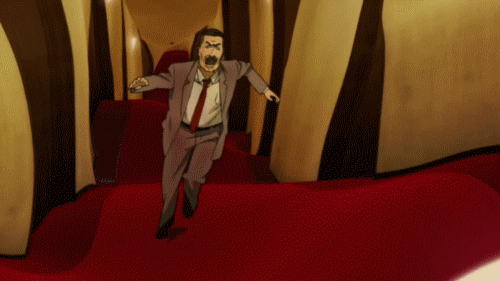|
Paprika the film is rather interesting in the way it’s presented. While the film has a rather intense genre-savvy thriller sequence thrown into the first scene of that subtly introduces the detective subplot, the book's opening may feel a tinge less, spicy.
Everything in the novel is handled much slower. Instead of Paprika dream bombing into Detective Toshimi Konakawa’s subconscious, the audience is introduced to Doctor Atsuko Chiba and Doctor Kohsaku Tokita discussing more work related issues over lunch.
This is one of the striking differences with how Kon adapts novel work, and how his cinematography can capture the novel’s highlights. So when James Monaco wrote that "whatever can be told in print in a novel can be roughly pictured or told in film."(44) it's important to keep in mind how adaptions can differ yet still tell a similair story. Let’s expand upon this by taking a look at the film’s opening scene. A man acts as if he’s on a stakeout and is seemingly betrayed by an old friend he trusted, as he slips through the floor of the circus tent to his probable death he’s saved by a young lady who the audience assumes is his ally in this world. The two of them then pass through a rather cinematic chase scene (that alludes to some popular movie such as 1963’s Russia with Love and 1953’s Roman Holiday ) only for the rhythm of the transition to stop at a rather bleak crime scene. Here, the man’s ’reality’ starts to break apart. The whole room slips away as he tries to run to the culprit, and he then falls into a blinding white abyss, with the words "but what about the rest of it?" triggering the end of his dream.

This opening scene is followed up by the proper explanation to that rather chaotic moment. Konakawa is a detective trying to find the murderer of a recent police case, but because he's been having so many anxiety ridden dreams he’s been unable to focus on his search. In comes the mysterious woman of Konakawa’s dreams. She introduces herself as a psychotherapist who has been using an experimental invention called the DC-mini to visually capture and record a person’s dreams to analyze the sources of their problems. Before she leaves his apartment she hands him a business card, implying that they will meet again. One flip of the card and the therapist’s name is revealed, Paprika.
While the power of the T1-Mini might seem unrealistic for it’s time, the actual process of using dreams in psychotherapy is one of the most common approaches in cognitive therapy. A collective piece by Rosner et. al. called Cognitive Therapy and Dreams states that this ’dream work’ is used to "increase the level and complexity of dream experience, to better understand the dream, to make connections between the dream and other issues of wakening life, and to proactively create alternative dreams."(130) all of these objectives are met during the detective’s continuous dream sequence.
Timothy Heidreich comments that "the artistry of cinematography comes in controlling what the viewer sees (or doesn't see) and how the image is presented." (3) Kon uses the first couple of minutes of Paprika to visually entice the viewers while still setting up a wildly comprehensible scene. The audience understands the man who is in focus is searching for someone, there is also a girl who is involved in his dreamlike narrative, and in the end of this scene the scientific explanation is given to ground viewers back into reality. Of course, that doesn't mean everything is explained. Satoshi Kon has a track record of presenting at least one mystery in every scene, something to keep the viewers curious, thinking, and absorbed into the fiction. That brings us to the next subject of interest, Paprika herself.
Paprika
Home
|

